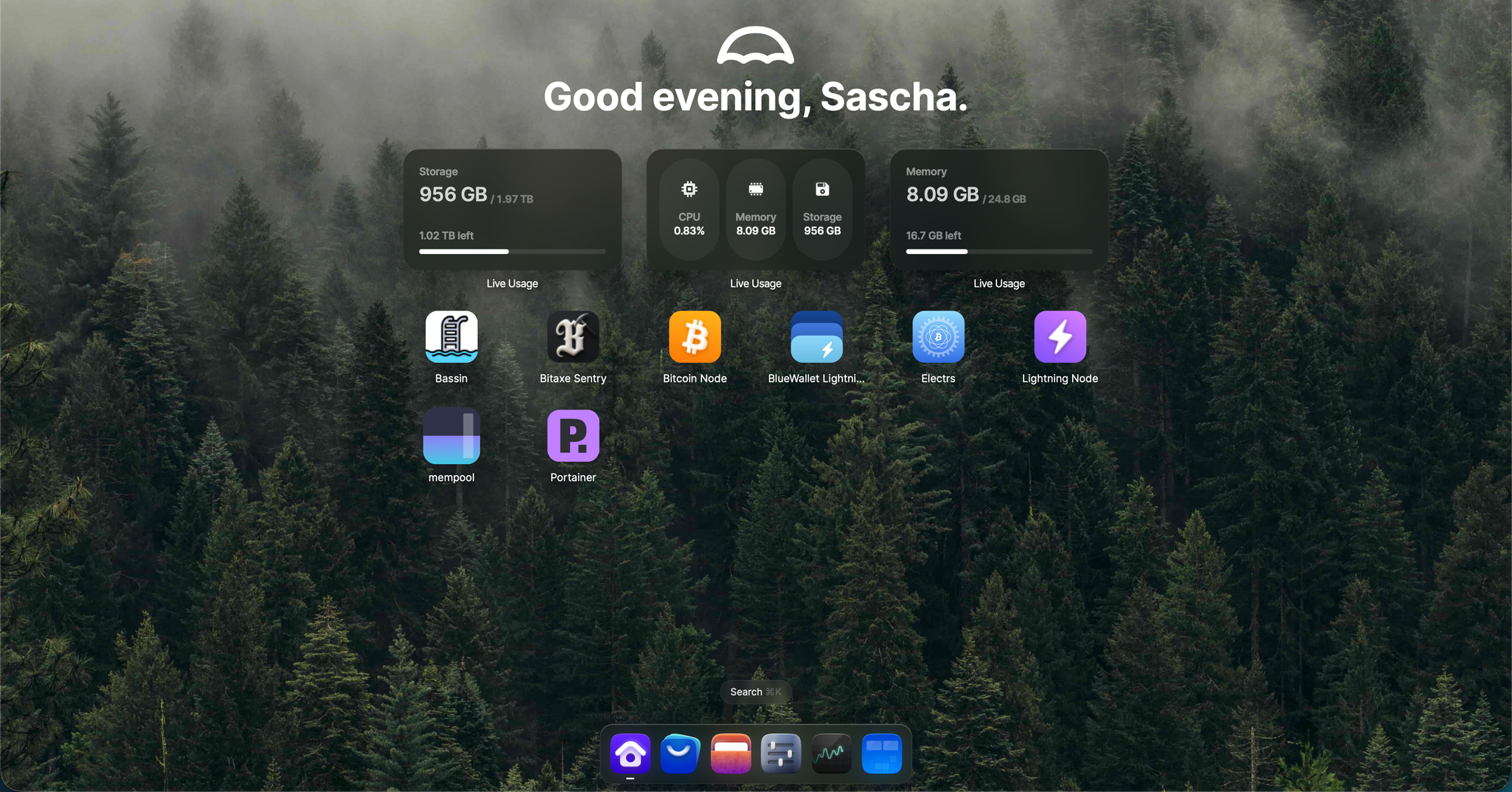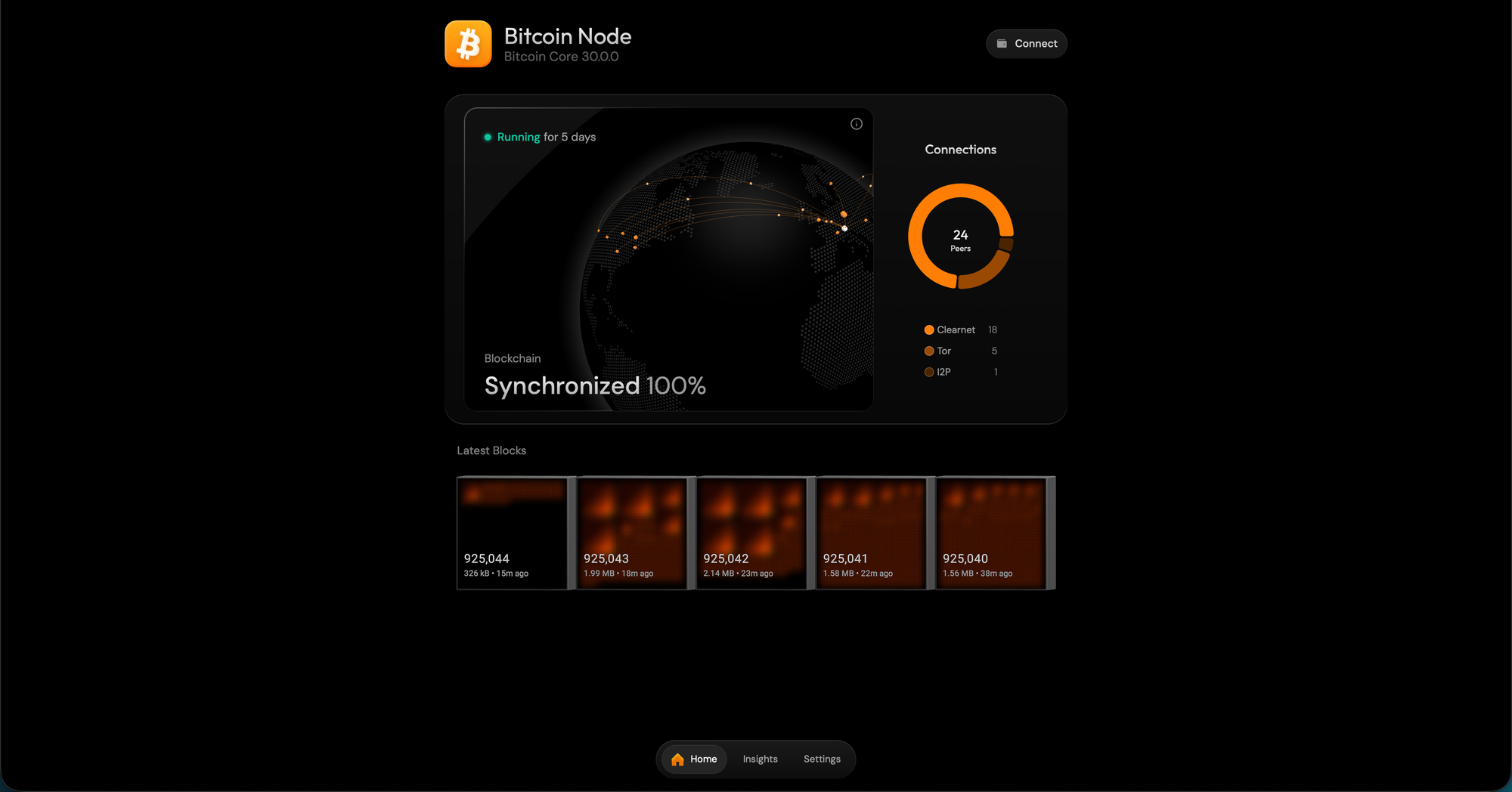Level Up your Crypto Game by Running Your own Bitcoin Lightning Node

Operating your own Bitcoin and Lightning stack is one of the most empowering steps you can take in the Bitcoin ecosystem.
Running your own Bitcoin node with Electrs and a Lightning node on Umbrel gives you full sovereignty over your funds and your privacy. You verify your own Bitcoin transactions, manage your own liquidity, and participate in the Lightning Network directly from a small, local server.
This post focuses on:
- How the Lightning Network works
- Running Bitcoin Core, Electrs, and Lightning Node on Umbrel
- Using Ride the Lightning (RTL) to move funds between Bitcoin and Lightning and to manage channels
- Creating channels to Kraken using information from Amboss
- Using Boltz to shift liquidity to the remote side of your Kraken channel
- Understanding why and how channel balancing works
- Sending and receiving Lightning payments
- Connecting your node to the Zeus mobile wallet

1. Lightning Network Theory — How It Really Works
Lightning is a second-layer protocol built on top of Bitcoin. Instead of broadcasting each payment to the blockchain, Lightning uses bidirectional payment channels that allow instant, low-fee transactions.
Payment Channels
A Lightning channel is a 2-of-2 multisig contract. Both peers lock funds into it. Inside the channel:
- Balances update instantly
- No on-chain transaction occurs
- Only the final channel state is settled when the channel closes
Commitment Transactions
Each channel state is represented by pre-signed commitment transactions. They enforce:
- Honest behavior
- Punishment for broadcasting outdated states
- Atomic updates across multiple routing hops using HTLCs
Routing
Payments are routed across the network using onion routing. Your node:
- Selects a path
- Encrypts each hop
- Uses HTLCs to enforce atomicity
Liquidity
This is the operational part:
- Outbound liquidity: how much you can send via Lightning
- Inbound liquidity: how much you can receive
Proper channel balancing ensures both directions are usable.
2. Running Bitcoin Core, Electrs, and Lightning on Umbrel
Umbrel simplifies running a Bitcoin stack:
- Bitcoin Core: Your full validating node
- Electrs: Accelerated wallet indexer
- Lightning Node (LND or CLN): Your Lightning implementation

Setting Up
After installing Umbrel:
- Install Bitcoin Node, Electrs, and Lightning Node
- Let Bitcoin sync fully
- Allow Electrs to index
- Initialize your Lightning node
Security Checklist
- Store your seed phrase offline
- Back up your macaroons
- Use Tor (Umbrel does this automatically)
- Expose no inbound ports—Tor obviates the need
3. Using Ride the Lightning (RTL) for Channel & Liquidity Operations
Umbrel includes Ride the Lightning, a powerful graphical UI for managing LND.
RTL allows you to:
- Move BTC from on-chain to Lightning and vice versa
- Open and close channels
- View routing information
- Inspect invoices and payments
- Monitor liquidity distribution
Moving Funds from Bitcoin to Lightning
In RTL:
- Go to Lightning → On-chain
- Deposit BTC to your on-chain wallet
- Use “Loop In / Loop Out” or “Open Channel” depending on what you want to do
Moving funds from on-chain to Lightning gives you outbound liquidity.
Moving Funds from Lightning to Bitcoin
RTL also supports sweeping Lightning funds back on-chain.
This is useful when rebalancing channels or reclaiming funds.
4. Creating a Channel to Kraken Using Amboss
Amboss (https://amboss.space) is the go-to directory for Lightning nodes.
Search for Kraken, and you’ll find:
- Their node public key
- Capacity
- Fees
- Uptime
- Policy settings
Kraken is one of the best nodes for:
- Large, stable channels
- Good routing connectivity
- Reliable inbound and outbound liquidity once balanced
Opening the Channel
In RTL or using lncli, open a channel to Kraken:
lncli openchannel \
--node_key=<kraken_node_pubkey> \
--local_amt=<amount_in_sats> \
--private=falseThis gives you outbound liquidity, but no inbound liquidity yet.
You’ll need inbound liquidity to receive Lightning payments.
5. Using Boltz to Shift Liquidity to Kraken’s Side Without Spending Money
This part is crucial.
You want Lightning inbound liquidity so you can receive payments.
But when you open a channel, all liquidity starts on your side.
What’s the Goal?
We want:
- Your channel with Kraken to have inbound liquidity
- Without spending money externally
- Without waiting for others to pay you first
How Boltz Helps
Boltz (https://boltz.exchange) offers non-custodial Lightning swaps.
For channel balancing, we use:
Lightning → Lightning rebalance
(or "Lightning swap" toward a partner)
Here’s what you do:
- Initiate a swap that pays Boltz over your Kraken channel
- Boltz returns the BTC back to you on-chain (or through another channel)
- Because the Lightning payment left your side of the Kraken channel,
the liquidity moves to Kraken’s side
No funds are lost—you're simply rearranging liquidity.
Why This Works
Imagine a channel with 1M sats, all sitting on your side because you just transferred it:
You ---- 1,000,000 sats | 0 sats ---- KrakenIf you send 300k sats to Boltz through Kraken:
You ---- 700,000 sats | 300,000 sats ---- Kraken- You now have 300k sats of inbound liquidity
- Kraken now holds that 300k sats within the channel
- Boltz sends you 300k sats back on-chain
Result:
You still own all your money, but your channel is now balanced to receive payments.
What happens when you send someone Satoshis using the Lighning Network
You ------- -300,000 sats | +300,000 sats ---- Kraken
Kraken ---- -300,000 sats | +300,000 sats ---- RecipientAs you can see, Kraken does not keep any of the satoshis that you send them, they forwarded them to the recipient. This creates the positive balance on the inbound liquidity side between you and Kraken. And this means your recipient also needs a positive, inbound liquidity balance with Kraken.
Otherwise, the transaction will result in an error.
6. Understanding Channel Balancing
Channel balancing is simply redistributing liquidity between the two sides of a channel without losing funds.
Outbound vs. Inbound
- Outbound liquidity = money sitting on your side of the channel
- Inbound liquidity = money sitting on their side of the channel
A channel is like a two-sided bucket.
When you pay through a channel, sats flow to the other side.
Balanced Channel Example
For example, after a Boltz rebalance:
You <----> Kraken
Outbound: 500k
Inbound: 500kThis lets you:
- Send up to 500k
- Receive up to 500k
A well-balanced channel behaves like a flexible payment pipe in both directions.
7. Sending & Receiving Lightning Payments
Once you have:
- A synced node
- A Kraken channel
- Balanced liquidity
…your Lightning node is ready.
Sending
- Scan an invoice
- LND finds a route automatically
- The payment succeeds if you have enough outbound liquidity
Receiving
- Create an invoice
- Share it
- The payer routes sats into your node, consuming inbound liquidity
8. Connecting Your Node to Zeus
Zeus is a secure mobile wallet that directly controls your Lightning node.
Steps to Connect
On Umbrel:
- Open the Lightning app
- Go to Connect Wallet
- Select Zeus
- Use the Tor connection QR code
- Scan it in Zeus
Zeus imports:
- Tor endpoint
- TLS cert
- Macaroons
You now control your Lightning node fully from your phone.
Summary
Running your own Bitcoin + Electrs + Lightning node on Umbrel gives you:
- Full verification
- Local indexing
- Lightning sovereignty
- Mobile access via Zeus
Using Ride the Lightning, Amboss, Kraken channels, and Boltz swaps, you can easily balance your channels to support both sending and receiving Lightning payments—without spending money externally.
Conclusion
Running your own Bitcoin and Lightning stack isn’t just a technical project—it’s a step toward true financial independence. When you verify every block yourself, manage your own liquidity, and route your own payments, you become an active participant in the Lightning ecosystem rather than a passive user of someone else’s infrastructure.
Umbrel makes the experience accessible. Electrs gives your wallets instant, private lookups. LND and Ride the Lightning give you deep visibility and precise liquidity control. Boltz empowers you to shape your channels without external spending. And with Zeus in your pocket, your Lightning node becomes a secure, mobile payments terminal you own completely.
This setup is powerful, flexible, and future-proof.
And it’s yours.
